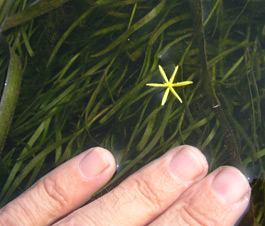| Submerged Aquatic Vegetation as Fisheries Habitat |
|
Habitat in the Chesapeake—shelter and food for the Bay’s living resources—must be plentiful and healthy in order to support a balanced ecosystem. Because submerged aquatic vegetation (SAV) plays a critical role in the Bay ecosystem, NOAA considers it an integral facet of ecosystem-based management and supports protection and restoration of SAV. SAV beds provide important habitat for many fish and shellfish, including juvenile blue crabs and finfish species such as spotted sea trout, menhaden, herring, shad, spot, croaker, weakfish, red drum, striped bass, and white perch. Juvenile blue crabs can be 30 times more abundant in SAV beds than in adjacent unvegetated areas. Many other species of fish and shellfish use SAV for shelter and as a place to find food. They eat the plants as well as the many small animals that live on and around the plants.
The habitat value of SAV beds for blue crabs is well known to crabbers. This photo shows a blue crab "doubler" caught in an SAV bed on the Severn River: a male on top holding a female "peeler" until she sheds in her final molt, which is the only time female crabs can mate. Many soft-shell crabs or “peelers” (crabs about to shed their shells) are caught in SAV beds around Tangier Sound by towing a crab scrape (a small dredge with no teeth) through the SAV beds with a small boat. Through the mid-1960s, when SAV was more abundant, one popular method for recreational crabbers was to wade through SAV beds with a long-handled net and a bushel basket with a lid in an inner tube. The water was clear enough to see crabs lurking in the SAV beds, where they were caught with the net and dropped into the basket. This method is little used today because SAV beds are too scarce and the water is too murky. More recent research has shown that both SAV and unvegetated sand and mud flats are important juvenile crab habitats. Together, those two habitats make up 20% of lower Bay aquatic habitats, but harbor about 90% of the juvenile crabs (Lipcius et al. 2005). The most important unvegetated sand and mud habitats for juvenile crabs are upriver flats near the turbidity maximum, where there is high deposition of organic-rich nutrients to feed the clams that crabs eat (Seitz et al. 2005). It appears that after they settle in downriver SAV beds, some juvenile crabs migrate upriver to these sand and mud flats, called secondary nurseries, sometimes in response to crowding in the SAV beds. Those secondary nurseries can have both higher crab survival (Lipcius et al. 2005) and higher growth rates (Seitz et al. 2005) compared to the primary nurseries in downriver SAV beds. Thus, even though SAV beds had the highest proportional abundance of juvenile crabs of all habitats surveyed, suggesting that juvenile crabs seek out SAV beds, the secondary nurseries may contribute more crabs to the adult population, as a result of higher survival and higher growth rates. Lipcius, R. N., R. D. Seitz, M. S. Seebo, and D. Colon-Carrion. 2005. Density abundance and survival of the blue crab in seagrass and unstructured salt marsh nurseries of Chesapeake Bay. Journal of Experimental Marine Biology and Ecology 319: 69-80. Seitz, R. D., R. N. Lipcius, and M. S. Seebo. 2005. Food availability and growth of the blue crab in seagrass and unvegetated nurseries of Chesapeake Bay. Journal of Experimental Marine Biology and Ecology 319: 57-68. |




